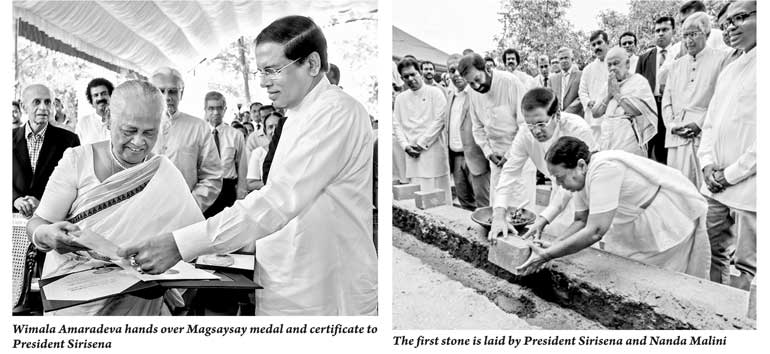Friday Mar 28, 2025
Friday Mar 28, 2025
Saturday, 9 September 2017 00:00 - - {{hitsCtrl.values.hits}}

 The Ramon Magsaysay award presented to Pandit Amaradeva now belongs to the people of Sri Lanka. As I read about the fine gesture by the Amaradeva family presenting the medal and the certificate to the President I was reminded of what Pandit Amaradeva said when he received the award 16 years back. “I consider it an honour conferred on the entire community of Sri Lankan artistes,” is how he reacted to the achievement.
The Ramon Magsaysay award presented to Pandit Amaradeva now belongs to the people of Sri Lanka. As I read about the fine gesture by the Amaradeva family presenting the medal and the certificate to the President I was reminded of what Pandit Amaradeva said when he received the award 16 years back. “I consider it an honour conferred on the entire community of Sri Lankan artistes,” is how he reacted to the achievement.
It was the highlight of the foundation-laying ceremony of the Pandit Amaradeva Sangeetha Asapuwa to be built at Battaramulla as a fitting tribute to the great musician. The President immediately handed over the award to be exhibited at the National Museum. Once the Asapuwa is opened it will find its due place there.
President Maithripala Sirisena made the ceremony a memorable event by inviting Nanda Malini to join him in laying the first stone along with him and then he offered the podium allotted to him to Professor Sunil Ariyaratne to deliver the memorial speech.
The ‘Pandit Amaradeva Sangeetha Asapuwa’ is will preserve the work done by the great musician over several decades towards creating a genuine Sinhala music tradition. It will be of great benefit to the future generations. While it fulfils a promise given by the President at Pandit Amaradeva’s funeral ceremony, Pandit Amaradeva himself had suggested the need of an institute of this nature.
The institute to be built on 120 perches land allotted by the Urban Development Authority (UDA) near ‘Ape Gama’ at Battaramulla, will comprise of a library, an archive, a museum and a preservation centre. It is estimated to cost around Rs. 250 million. It will facilitate academics to do research in Sri Lankan music. There will be listening rooms in addition to spaces for art lovers to brainstorm and discuss creative matters.
The land has been donated to the Amaradeva Foundation. In addition, a budgetary allocation of Rs. 25 million from the votes of the Ministry of Mass Media was also approved by towards the expenses of the construction of the Centre. The keen interest shown by the then Media Minister Gayan Karunatilleka obviously led to quick action been taken in providing the land and the funds. Present Minister Mangala Samaraweera is also bound to watch the progress closely.
It’s one rare instance when a promise made at the funeral of a national icon has been fulfilled even before the first death anniversary – a most commendable gesture. Now it is the responsibility of the Foundation which has been given the land, to collect the funds without delay and complete the project. There is bound to be benefactors giving a helping hand.
I remember how the Observer started a fund in building the Navarangahala at the Royal College premises on the initiative of Royal Junior Principal H.D. Sugathapala, whose services to uplift the Sinhala theatre was enormous. The unique mural on the wall at the entrance was done by renowned sculptor Tissa Ranasinghe tracing the history of drama in Sri Lanka.
This was in the 1960s when the only places available to stage dramas were the school hall at the Lumbini Maha Vidyalaya at Havelock Town and the YMBA hall at Borella. Lumbini hall was the venue of the annual State Drama Festival.
While the Navaragahala Fund was slowly building up, dramatists, actors and lovers of theatre rallied round and held shramadana campaigns to help the building activities in numerous ways. Publicity was given by the Observer regularly on the progress of the project.
From the Navarangahala days we have come a long way and the arts have progressed steadily. Technology is advancing rapidly and the local artistes are keeping pace. There is enormous talent among the youngsters. Taste of the average viewer and listener has also improved and they demand high quality productions be it drama, film, music or painting.
Discover Kapruka, the leading online shopping platform in Sri Lanka, where you can conveniently send Gifts and Flowers to your loved ones for any event including Valentine ’s Day. Explore a wide range of popular Shopping Categories on Kapruka, including Toys, Groceries, Electronics, Birthday Cakes, Fruits, Chocolates, Flower Bouquets, Clothing, Watches, Lingerie, Gift Sets and Jewellery. Also if you’re interested in selling with Kapruka, Partner Central by Kapruka is the best solution to start with. Moreover, through Kapruka Global Shop, you can also enjoy the convenience of purchasing products from renowned platforms like Amazon and eBay and have them delivered to Sri Lanka.
Discover Kapruka, the leading online shopping platform in Sri Lanka, where you can conveniently send Gifts and Flowers to your loved ones for any event including Valentine ’s Day. Explore a wide range of popular Shopping Categories on Kapruka, including Toys, Groceries, Electronics, Birthday Cakes, Fruits, Chocolates, Flower Bouquets, Clothing, Watches, Lingerie, Gift Sets and Jewellery. Also if you’re interested in selling with Kapruka, Partner Central by Kapruka is the best solution to start with. Moreover, through Kapruka Global Shop, you can also enjoy the convenience of purchasing products from renowned platforms like Amazon and eBay and have them delivered to Sri Lanka.